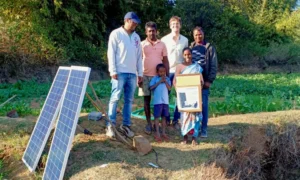The disposal of crop residue has become a matter of utmost concern and worry for farmers in the last few years. In many states they are forced to burn the residue after harvesting the crops in order to prepare the ground for their next sowing and this has led to even greater concerns.
However, help seems to be at hand as agricultural scientists have found a way to effectively deal with the residue and at the same time enrich the soil.
Scientists from the Central Soil Salinity Research Institute, Lucknow have developed a formula, called Halo CRD, that will take not just care of the crop residue, but will also increase the fertility of the soil.
“Crop residue is a big problem for farmers, and the centre has been working for several years to find a solution that will take care of it,” Sanjay Arora, principal scientist, Central Soil Salinity Research Institute, Lucknow, told Gaon Connection.
According to Arora, the bacteria in the Halo CRD formula helps to decompose the crop residue, so the farmers do not need to burn the residue anymore. In addition, the decomposed residue now increases the health and fertility of the soil. “This will help the next round of crops that are sown in the land,” Arora pointed out.
How to use Halo CRD
To be effective, 100 millilitres (ml) of the Halo formulation is mixed with 200 litres of water and 500 grams of jaggery along with two kilograms of cow dung. The mixture is allowed to stand for two to three days in the shade after which two to three litres of whey is added to it. Approximately 200 litres of the mixture is required for an acre of land.
For best results the mixture is sprinkled over the land in two instalments over a week. In the space of 25 to 30 days the crop residue will decompose completely.
According to the Central Soil Salinity Research Institute, nearly 600 metric tonnes of crop residue are left behind in the fields every year. Uttar Pradesh leads in the amount of crop residue followed by Punjab.
Also Read: Nourishing change: In Unnao, UP, an initiative to prevent stubble burning
The Halo CRD formula has been distributed by the Krishi Vigyan Kendras in Uttar Pradesh to farmers in Lucknow, Raebareli, Unnao, Sitapur, Sultanpur, Kaushambi, Hardoi, Pratapgarh, Agra and Etawah. The districts have shown promising results in the use of the formula, said the scientist.
The Halo CRD is available at Krishi Vigyan Kendras in the districts. A 100 ml bottle is priced at Rs 50.
Read the story in Hindi



















